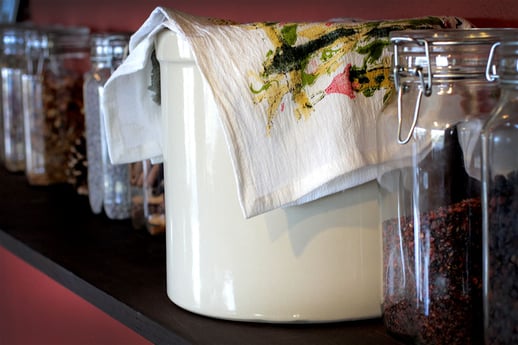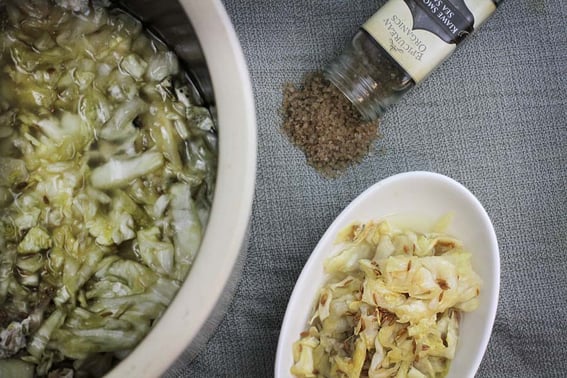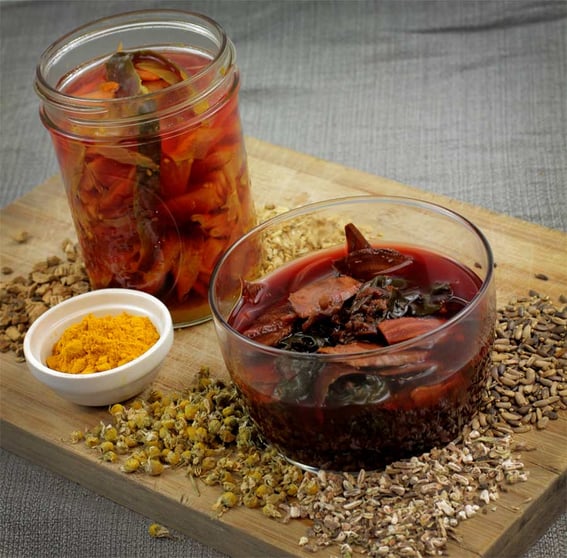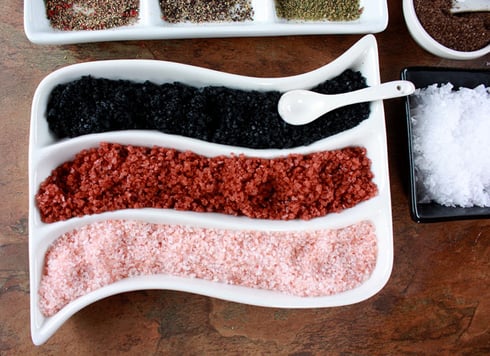If you can chop and stir, you can create delicious, healthy, and amazing fermented vegetables. Right in your own kitchen! You do not need fancy crocks and equipment (although a good crock is a delight) and you can use all sorts of vegetables, spices, and salts. There is no one right recipe!
We love to use dill, cumin, coriander, fennel seed, celery seed, pickling spice, red chili flakes, peppercorns, cloves, juniper berries, fenugreek, bay leaves, garlic, onion, rosemary, and so much more!
Fermentation is technically the anaerobic conversion of sugar to carbon dioxide and alcohol by yeast. You may have heard that fermented foods are good for you and it's true; fermenting can make foods easier on the tummy. You may be surprised to learn how many foods we eat are actually already fermented: pickles, of course, but also cheese, bread, tempeh, yogurt, cider, beer, wine, and more!
We it would be fun to share our favorite Sauerkraut and Kimchi recipes. This blog inspired a little experimentation and a lot of tasting. We've got a little bitter, a little sweet, a little salty and a whole lot of yum!
Mason's Black Salt Sauerkraut Recipe
Ingredients:
- Red cabbage, organic (washed)
- Black Lava Salt
- Cheesecloth
Directions:
- Slice red cabbage into thin strips.
- As cabbage is added to a large ceramic crock, sprinkle with about 1/2 teaspoon of Black Lava Salt.
- Scrunch the cabbage and salt together with clean hands. Pack another layer of red cabbage and then salt--continue layering and scrunching, until you've used up all the cabbage.
- Pack cabbage down as tightly as possible until liquid or brine comes up over the top of the cabbage. You can taste the brine at this point to see if you'd like to add more salt. You may need to add water to the mix to get enough liquid to cover. Cover cabbage with cheesecloth and use something to weight the cheesecloth down over the cabbage and salt mixture. Loosely cover the jar with plastic wrap or a towel and put aside - away from direct light and heat. Check every couple days. You may want to replace the cheesecloth if it gets too damp. After a couple weeks, taste to see how things are going. Once it gets to the taste and texture you like, refrigerate and enjoy.
Kori's Classic Kraut Recipe
Ingredients:
- Green cabbage, organic (washed)
- Kiawe Smoked Sea Salt
- Organic Caraway seeds
Directions:
- Slice green cabbage into thin slices.
- Using a ceramic crock or large bowl (ceramic, glass, or stainless steel), layer sliced cabbage about 1-2 inches thick.
- Pack down and sprinkle with a pinch of Kiawe Smoked Sea Salt and a pinch of organic Caraway seeds.
- Continue packing alternate layers of cabbage and seasonings until all of the cabbage is used.
- Use a plate pressed down over the mixture to press down tightly.
- Allow to sit, covered with a clean towel over night.
- Liquid should be extracted and rise up over the top of the cabbage when pressed down, but if it doesn't, add a little more brine.
- Add 1/2 teaspoon Kiawe Smoked Sea Salt per 1 cup of water, stir and then pour over cabbage mixture.
- Once the brine is covering the cabbage, press the plate back down over the top and put a weight on it - a clean jar weighted with dried beans works well.
- Cover with the towel and set out of direct heat and light. Check every couple days.
- After a couple weeks, taste to see how things are going.
- In warm weather, fermentation will happen quicker, while it might take longer in colder months.
- When it gets to the taste and texture you like, feel free to eat!
- Refrigerate or you can preserve using a hot water bath method of canning.
Alieta's Herbal Fermentations
A note from Alieta: I made these combinations specifically to create an ultra tummy treat. It's good for general tummy attention or to help your transition during diet changes.
Beet Kim-Tea Recipe
Ingredients:
- 1 bunch organic (4) purple beets with greens
- 2 organic parsnips
- Sea Salt
- 2 Tbsp. organic Dandelion Root
- 2 Tbsp. organic Milk Thistle Seed
- ¼ cup organic Chamomile Flowers
- 1 Tbsp. raw, organic honey
Directions:
- Cut the green tops from the beets and chop them up into manageable bite sizes.
- Set aside in a bowl, making one layer of beet greens and then doing one layer of sprinkled salt, repeating until all the greens have been sprinkled with salt.
- Cover with water and soak overnight.
- Drain brine – reserving brine liquid for later. Chop up remaining veggies.
- Mix together 1 cup of brine with 2 tablespoons of honey, add Dandelion Root, Milk Thistle Seed, and Chamomile Flowers.
- Place 1/4 cup of your mixture in the bottom of a 2-quart container (or container of choice) and stuff with veggies-- making alternating layers of veggies/herbal mixture. Once full, cover with the reserved brine. You want to make sure your veggies are covered with brine at all times. If your container is wide enough, use a plate to weigh the mixture down.
- Cover everything with a clean cloth and set aside somewhere safe and out of direct sunlight. Do not twist a lid on your container at this point, the fermenting will cause it to bubble up and could possibly explode if you shut a lid tight on here during fermentation! Don't be surprised if your container bubbles over a bit, if your veggies and brine are within an inch to the top of the container this will most likely happen!
- You can place your container on a small plate to help keep from cleaning up a big mess every day.
- Leave for 7-14 days and taste.
- Add more salt to taste.
Bitter Herbal Kraut Recipe Recipe
Ingredients:
- Small head purple cabbage
- 3-4 large organic carrots
- 2-3 organic rhutabaga
- Sea Salt
- 2 Tbsp. fresh minced garlic or 2 Tablespoons organic dried minced garlic
- 1 Tablespoon organic Gentian Root *
- 1 Tablespoon organic Turmeric Root Powder
- 1 Tablespoon raw, organic honey
- *Go very lightly with the Gentian root or the whole batch will taste much too bitter, I would use no more than a tsp per quart. For this recipe I am using a half gallon (2 qt) ball jar.
Directions:
- Chop cabbage into manageable slices
- Make layers of cabbage and salt
- Completely cover with water and let sit overnight in a ceramic or stainless steel container.
- Drain brine – reserving brine liquid for later use.
- Chop the rest of your vegetables into manageable pieces, the thinner the better -- I prefer using a food processor with a grater. You will set the rest of your veggies aside for the morning preparation!
- Mix together 1 cup of brine with 1 Tbsp. of honey, Turmeric, Gentian Root (be careful of the amount!) and fresh or dried Garlic.
- Pour a quarter cup of the mixture into the bottom of large glass jar, make layers of Cabbage, Carrots, and Rutabaga with the honey and brine mixture in between.
- Once full, cover with remaining brine.
- Let sit on counter for at least 7 days, covered but not shut tight (the fermentation process could cause your jar to erupt!). Since my container was too narrow to use a plate to weigh down my veggies, I filled a small plastic bag with additional brine and placed it on top inside of my jar.
- Again, if your brine and veggies came within an inch of the top of your jar you will most likely have some bubbly fermentation seep out of your container -- this is fine -- you can leave your jar on a plate to help catch some of it if you would like.
- Add more salt if necessary for taste.
Happy Fermenting!














